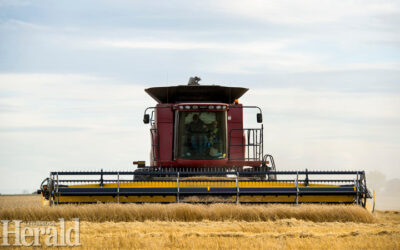Wheat stripe rust ‘one of the most destructive foliar diseases’ says research scientist
By Al Beeber on May 27, 2021.
 A combine picks up a crop of wheat during a past harvest season in a field on the southeast edge of the city. Herald file photo
A combine picks up a crop of wheat during a past harvest season in a field on the southeast edge of the city. Herald file photoLETHBRIDGE HERALDabeeber@lethbridgeherald.com
It’s a problem that can affect 88 per cent of the world’s wheat varieties and causes $1 billion US damage annually. And wheat stripe rust is here in Alberta.
The infection has become problematic in Canada since around 2000 but farmers can reduce its impact, research scientist Reem Aboukhaddour told the In the Field webinar Wednesday morning.
“Stripe rust can infect a host plant at any stage from seedling to maturity,” said Aboukhaddour, whose talk addressed the history of stripe rust, its migration throughout the world and the research being done on it.
“It’s one of the most destructive foliar diseases around the world if we speak as of today. The pathogen can infect any green part of the host.”
Aboukhaddour, who works at Agriculture and Agri-Food Canada Lethbridge, said spores have reached Canada “on two types of wind trajectory,” the virulence found in Alberta and B.C. being related to outbreaks in California and the U.S. Pacific Northwest.
The disease is believed to have originated in the Himalayas and then spread to Europe, North America and Australia, Aboukhaddour said. Its impact has been felt around the world including countries in South America such as Chile, Argentina and Brazil, as well as Atlantic Europe and some high elevation areas in east Africa. China and Nepal have also been affected, she said.
“Spores are microscopic, very small and light and travel thousands of kilometres yet still remain viable to cause infection in totally different geographical areas, said Aboukhaddour.
She said the pathogen can evolve at a local level.
Wheat is more susceptible than barley or triticale to stripe rust, a cereal disease caused by the Puccinia striiformis fungus, according to the Alberta government.
Infections “rob nutrients and sugars from the host plant while the infected tissues on the leaf surface reduce the photosynthesizing area of the plant and cause excessive moisture loss. These conditions reduce plant survival, head development, grain development, grain filling, yield, grain grade and quality,” says the Alberta.ca website.
“Stripe rust is considered one of the most damaging diseases since 2000. That doesn’t mean it wasn’t occurring before; it was,” Aboukhaddour added.
Stripe rust is “kind of restricted in Alberta and B.C. most often but recently it has also been showing toward the eastern area” of Canada, she said.
An annual severity survey is done in southern Alberta fields during the growing season, said Aboukhaddour, who collaborates with numerous colleagues in central Alberta and the north.
“We try to go in different fields through the growing season and we take a database on the severity and incidence and classify fields into clean like having no infection or having light infection, usually less than five per cent; moderate five to 10 and severe, anything over 10.”
“The collection of this data long-term will provide really good solid information.”
In 2020, 43 fields — 55 per cent — were clean. Ten fields, or 12.5 per cent, were listed as severe. Severe cases in 2020 were the highest since 2016 when 11 per cent were given that designation.
Since 2010, the most dominant stripe rust races in the U.S. and Canada have been the same but race structure has varied by provinces and there are unique races in Canada, according to a graphic supplied by Aboukhaddour.
Races “are like a coded language to communicate new virulence incursions,” according to a graph she put on the screen for participants.
Potential yield loss from rust stripe can range up to 80 per cent on susceptible plants.
Reducing damage from stripe rust can be accomplished in several ways, she said.
One is to avoid the early planting of winter wheat. Another is to reduce volunteer plants and grasses because spores can over-winter in hosts and a third is to avoid excessive irrigation and fertilizing, she said. Lastly, growers can project the flag leaf of wheat.
Stripe rust, she says, prefers cool and moist springs for infections and was initially restricted to areas with those conditions in higher elevations. After 2000, Aboukhaddour said the disease expanded its geographic boundary “and became a problem where ever wheat is grown.”
According to Alberta.ca, “stripe rust attacks all the above-ground parts of the wheat and barley plant. On young plants the pustules occur in blotches covering large areas of affected leaves. On older plants (after the jointing stage of growth) the powdery masses (pustules) of yellow-orange spores are arranged in parallel lines, giving affected leaves a characteristic striped appearance.”
Breeding programs are underway in western Canada for stripe rust resistance in wheat and barley. Stripe rust ratings can be found in the Alberta Seed Guide.
Follow @albeebHerald on Twitter
Follow @albeebHerald on Twitter
4-3


